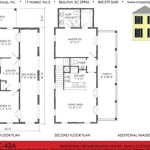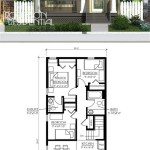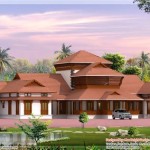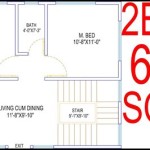A 2-bedroom tiny house floor plan is a meticulously designed layout for a compact home that accommodates two separate bedrooms within its limited square footage. Tiny houses, known for their smaller size and emphasis on efficient space utilization, present unique challenges in fitting essential living spaces into a reduced footprint. A well-conceived 2-bedroom tiny house floor plan efficiently arranges sleeping quarters, common areas, and other essential functionalities within the confines of this diminutive structure.
Floor plans for 2-bedroom tiny houses vary in their configurations, reflecting the diverse needs and preferences of homeowners. Some designs feature bedrooms located on opposite ends of the house, offering privacy and separation. Other plans incorporate loft spaces, with one or both bedrooms situated above the main living area, maximizing floor space below. Creative solutions, such as folding walls or convertible furniture, are often employed to enhance flexibility and optimize space within these compact homes.
In the following section, we will delve into specific floor plans for 2-bedroom tiny houses, exploring their diverse layouts, space-saving strategies, and innovative features. By examining these plans, we gain insights into the art of designing functional and comfortable living spaces within the constraints of tiny house living.
When designing 2-bedroom tiny house floor plans, several key considerations come into play. These include:
- Maximizing space
- Creating separate sleeping areas
- Incorporating clever storage solutions
- Optimizing natural light
- Ensuring privacy
- Balancing functionality and aesthetics
- Considering future needs
- Adhering to building codes
- Keeping costs within budget
By carefully addressing these factors, homeowners can create comfortable and functional 2-bedroom tiny houses that meet their specific needs and aspirations.
Maximizing space
In the realm of 2-bedroom tiny house floor plans, maximizing space is paramount. Every square foot must be utilized efficiently to create a comfortable and functional living environment. Several strategies can be employed to achieve this goal:
- Loft bedrooms: Utilizing vertical space by incorporating loft bedrooms is a clever way to create separate sleeping areas without sacrificing valuable floor space below. Accessed by ladders or stairs, loft bedrooms offer privacy and coziness while freeing up the main level for other essential functions.
- Multi-purpose furniture: Choosing furniture that serves multiple purposes is a smart space-saving strategy. For instance, ottomans with built-in storage can double as seating and storage containers. Similarly, beds with drawers or trundles provide additional storage space for linens, clothing, or other items.
- Foldable and retractable elements: Incorporating foldable or retractable elements into the design can significantly enhance space flexibility. Folding tables, chairs, and even walls can be temporarily extended when needed and folded away to save space when not in use.
- Decluttering and organization: Maintaining a clutter-free and organized living space is crucial for maximizing space in a tiny house. Implementing smart storage solutions, such as built-in shelves, drawers, and baskets, helps keep belongings organized and out of sight, creating a sense of spaciousness.
By implementing these space-saving strategies, homeowners can optimize the use of every square foot in their 2-bedroom tiny house, ensuring a comfortable and functional living environment despite its compact size.
Creating separate sleeping areas
In a 2-bedroom tiny house, creating separate sleeping areas is essential for ensuring privacy and comfort for all occupants. Several clever design strategies can be employed to achieve this:
- Loft bedrooms: Utilizing vertical space by incorporating loft bedrooms is a popular option. Accessed by ladders or stairs, loft bedrooms provide a private and cozy sleeping space while freeing up valuable floor space below for other essential functions.
- Partitioned bedrooms: Dividing the main living area into separate sleeping areas using partitions or curtains can create distinct private spaces for each bedroom. This approach allows for a more traditional bedroom layout while maintaining an open and airy feel.
- Bunk beds: Bunk beds are a space-saving solution that is particularly well-suited for tiny houses with limited floor space. They allow for two separate sleeping areas to be stacked vertically, maximizing space utilization.
- Murphy beds: Murphy beds, also known as wall beds, are a clever space-saving solution that allows beds to be folded up and stored against the wall when not in use. This frees up valuable floor space during the day, creating a more spacious and versatile living area.
By implementing these design strategies, homeowners can create separate and private sleeping areas in their 2-bedroom tiny house, ensuring a comfortable and restful environment for all occupants.
Incorporating clever storage solutions
Utilizing vertical space
In a tiny house, every inch of space is precious, so utilizing vertical space is essential. Wall-mounted shelves, cabinets, and drawers can provide ample storage without taking up valuable floor space. Vertical storage solutions are particularly useful in small bedrooms, where floor space is often limited. Consider installing floating shelves above the bed or using stackable bins and baskets to maximize vertical space.
Multi-purpose furniture
Multi-purpose furniture is a great way to save space and add functionality to your tiny house. Ottomans with built-in storage can double as seating and storage containers, while beds with drawers or trundles provide additional storage space for linens, clothing, or other items. Look for furniture that can serve multiple purposes, such as a coffee table with built-in drawers or a sofa with hidden storage compartments.
Hidden storage
Hidden storage solutions can help you keep your tiny house clutter-free and organized. Consider incorporating hidden storage compartments into your walls, floors, or ceilings. For example, you could install a Murphy bed that folds up into the wall when not in use, or create a hidden storage space under the stairs. By utilizing hidden storage solutions, you can keep your belongings out of sight and maintain a sense of spaciousness in your tiny house.
Smart organization
Smart organization is key to maximizing storage space in a tiny house. Invest in stackable bins, baskets, and drawer organizers to keep your belongings tidy and organized. Utilize vertical space by using shelves and drawers to store items that would otherwise clutter up your floors. Regularly declutter and purge any items you no longer need to keep your tiny house feeling spacious and organized.
By incorporating these clever storage solutions into your 2-bedroom tiny house floor plan, you can create a functional and organized living space that meets your needs without sacrificing comfort or style.
Optimizing natural light
Incorporating ample natural light into your 2-bedroom tiny house floor plan is crucial for creating a bright, airy, and inviting living space. Natural light reduces the need for artificial lighting, saving energy and creating a more natural and healthy indoor environment. Here are some key strategies for optimizing natural light in your tiny house:
- Large windows and skylights: Installing large windows and skylights throughout your tiny house is an effective way to maximize natural light. South-facing windows are ideal for capturing the most sunlight, but windows on multiple sides of the house will provide even illumination. Consider installing skylights in areas with limited wall space, such as bathrooms or kitchens, to bring in additional natural light.
- Light-colored walls and ceilings: Light-colored walls and ceilings reflect more light, making your tiny house feel brighter and more spacious. Avoid using dark colors, which absorb light and can make your house feel smaller and darker.
- Avoid obstructing windows: When arranging furniture and dcor, be mindful of not blocking windows or skylights. Keep furniture and plants away from windows to allow natural light to flow freely into the space.
- Use mirrors: Mirrors can reflect and amplify natural light, making your tiny house feel brighter and more spacious. Place mirrors opposite windows or in areas with limited natural light to bounce light around the room.
By incorporating these strategies into your 2-bedroom tiny house floor plan, you can create a bright, airy, and inviting living space that is filled with an abundance of natural light.
Ensuring privacy
Privacy is an important consideration in any home design, and it is especially crucial in a tiny house where space is limited. Here are some key strategies for ensuring privacy in a 2-bedroom tiny house floor plan:
- Separate sleeping areas: Creating separate sleeping areas for each bedroom is essential for ensuring privacy. This can be achieved through the use of loft bedrooms, partitioned bedrooms, or bunk beds. Each sleeping area should provide a private and secluded space for each occupant.
- Private bathrooms: If space allows, incorporating a private bathroom for each bedroom can greatly enhance privacy. This eliminates the need to share a bathroom with other occupants, providing a private and comfortable space for each individual.
- Soundproofing: Utilizing soundproofing materials in walls and floors can help to minimize noise transfer between different areas of the house. This is especially important in tiny houses, where noise can easily travel through the compact space.
- Window coverings: Installing blinds, curtains, or other window coverings on all windows and skylights provides privacy from the outside world. This allows occupants to control the amount of light and visibility into the house, ensuring privacy when desired.
By incorporating these strategies into your 2-bedroom tiny house floor plan, you can create a comfortable and private living space that meets the needs of all occupants.
Balancing functionality and aesthetics
Prioritizing functionality
In a tiny house, every square foot must serve a purpose. Functionality should be the primary consideration when designing your floor plan. This means carefully considering the essential functions that need to be accommodated, such as sleeping, cooking, eating, bathing, and storage. Each space should be designed to maximize efficiency and minimize wasted space.
Incorporating aesthetic elements
While functionality is paramount, aesthetics should not be neglected. A well-designed tiny house should be both functional and aesthetically pleasing. This can be achieved by incorporating visually appealing elements into the design, such as natural materials, stylish fixtures, and a cohesive color scheme. By carefully selecting materials and finishes, you can create a tiny house that is both beautiful and practical.
Creating a cohesive design
Balancing functionality and aesthetics also involves creating a cohesive design that flows seamlessly throughout the tiny house. This means paying attention to the overall layout, as well as the details of each individual space. The design should be visually appealing and inviting, while also ensuring that all essential functions are met. By carefully considering the relationship between different spaces and elements, you can create a tiny house that is both stylish and functional.
Seeking professional advice
If you are struggling to balance functionality and aesthetics in your tiny house floor plan, consider seeking professional advice from an architect or interior designer. These professionals can help you create a design that meets your specific needs and preferences, while also ensuring that your tiny house is both functional and beautiful.
By carefully balancing functionality and aesthetics, you can create a 2-bedroom tiny house floor plan that is both practical and visually appealing. This will ensure that your tiny house is a comfortable and enjoyable place to live.
Considering future needs
When designing a 2-bedroom tiny house floor plan, it is important to consider not only your current needs but also your future needs. Tiny houses are often built to be adaptable and expandable, so it is important to think ahead and design a floor plan that can accommodate your changing needs over time.
- Changing family dynamics: If you are planning to start a family or have children in the future, you will need to consider how your tiny house floor plan can accommodate their needs. This may mean incorporating a loft bedroom for additional sleeping space, or designing a floor plan that can be easily modified to add an additional bedroom or bathroom.
- Aging in place: If you are planning to age in place in your tiny house, you will need to consider how the floor plan can be modified to accommodate your changing needs as you get older. This may mean widening doorways and hallways to accommodate wheelchairs or walkers, or installing grab bars and other safety features in the bathroom.
- Resale value: If you think you may eventually sell your tiny house, you will need to consider how your floor plan will appeal to potential buyers. A well-designed floor plan that can be easily adapted to different needs will be more attractive to buyers and will help you get a better return on your investment.
- Flexibility and adaptability: Tiny houses are often built to be flexible and adaptable, so you can modify the floor plan to meet your changing needs over time. This may mean designing a floor plan that can be easily reconfigured to create different spaces, or incorporating features that can be added or removed as needed.
By considering your future needs when designing your 2-bedroom tiny house floor plan, you can create a home that will meet your needs for years to come.
Adhering to building codes
Building codes are essential regulations that ensure the safety and habitability of structures. When designing and constructing a 2-bedroom tiny house, it is crucial to adhere to all applicable building codes. These codes vary by location, so it is important to check with your local building department to determine the specific requirements for your area.
Building codes typically cover a wide range of topics, including structural integrity, fire safety, electrical safety, plumbing, and energy efficiency. By adhering to these codes, you can ensure that your tiny house is safe, durable, and energy-efficient. Failure to comply with building codes can result in fines, construction delays, or even the inability to obtain a building permit.
One of the most important aspects of building code compliance is structural integrity. Tiny houses must be designed and constructed to withstand the loads and forces that they will be subjected to, including wind, snow, and earthquakes. Building codes specify the minimum requirements for structural components, such as framing, foundation, and roofing. By following these requirements, you can ensure that your tiny house is safe and stable.
Fire safety is another critical consideration in building code compliance. Tiny houses must be equipped with smoke detectors, fire extinguishers, and other fire safety features to minimize the risk of fire and protect occupants in the event of a fire. Building codes specify the minimum requirements for fire safety features, such as the number and location of smoke detectors, the type of fire extinguishers required, and the flame spread rating of interior finishes.
By adhering to building codes, you can ensure that your 2-bedroom tiny house is safe, durable, and energy-efficient. Building codes are in place to protect the health and safety of occupants, and by following these codes, you can help to ensure that your tiny house is a safe and comfortable place to live.
Keeping costs within budget
Building a tiny house can be a cost-effective way to achieve homeownership, but it is important to carefully consider your budget before starting construction. Here are some key strategies for keeping costs within budget when designing and building a 2-bedroom tiny house:
1. Choose an affordable floor plan
The floor plan is one of the most important factors that will affect the cost of your tiny house. A simple, compact floor plan will be less expensive to build than a complex, spacious floor plan. When choosing a floor plan, consider your essential needs and try to avoid unnecessary features or amenities that will add to the cost.
2. Select cost-effective materials
The materials you choose for your tiny house will also have a significant impact on the cost. There are many affordable materials available that can be used to build a durable and attractive tiny house. Consider using recycled materials or reclaimed wood to save money. You can also save money by choosing simple finishes and fixtures.
3. Keep the square footage small
The square footage of your tiny house is another major factor that will affect the cost. The smaller the house, the less it will cost to build. When designing your floor plan, try to keep the square footage to a minimum while still ensuring that the house is comfortable and functional.
4. Do some of the work yourself
If you have the skills and time, you can save money by doing some of the work on your tiny house yourself. This could include tasks such as framing, installing insulation, or painting. Even if you are not able to do all of the work yourself, you can still save money by hiring contractors to do specific tasks, such as electrical work or plumbing.
By following these strategies, you can keep the costs of your 2-bedroom tiny house within budget. Building a tiny house can be an affordable way to achieve homeownership, but it is important to carefully plan your budget and choose cost-effective options.









Related Posts








